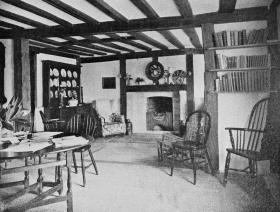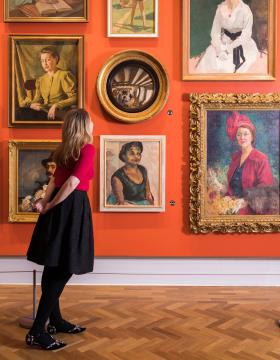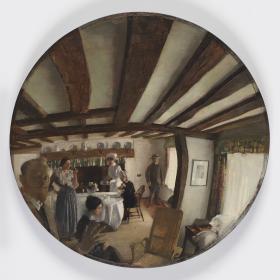Although only 39 centimetres in diameter, George Lambert’s painting The Convex Mirror asserts its place among the 300 artworks in the Library’s Paintings from the Collection exhibition.
Given to the Library in 2012 as part of a bequest from the collector Helen Selle, there is no greater example of a mirror’s inspiration in creating an Australian masterpiece. And the story behind its creation is itself a mirror of the emotional life of its painter, of the Lambert family and of their friends in Edwardian England.
The painting depicts a peephole view into an English country sitting room, captured in the reflection of a convex mirror. Such mirrors, uniquely, expand everything in the immediate foreground and then recede sharply into vertiginous space to produce an arresting, even mesmerising, effect.
The room in the painting was in Belwethers, the country home of Lambert’s friends Arthur and Orovida Halford. As his wife, Amy, wrote in an account of 30 years of her family’s often expatriate life, one of her fondest memories was of time spent with the Halfords and their extended family at Belwethers in Surrey.
Amy recalled an intimate friendship that began in 1901 after the newly-wed Lamberts arrived in London from Australia. As frequent guests at Belwethers, they met Mary, one of the three Halford daughters, and her husband, Sir Edmund Davis. Their immediate rapport with this pair of millionaire art collectors led to Lambert accepting their offer of an art studio at their London property Lansdowne House.
Orovida Halford died in December 1914, soon after the outbreak of the First World War, and the Davises inherited her country home. Six months later, the Lamberts’ youngest son Constant, who was enrolled at a boarding school in Surrey, contracted a life-threatening illness. While they nursed him back to health, they stayed at Belwethers and were supported by their friends Mary and Edmund.
As a tribute to the Davises’ sympathy and hospitality, Lambert painted The Convex Mirror some time in 1916. The established portrait artist took on the unusual and challenging form as a distraction from the ongoing conflict and from his son’s near fatal illness.

Half the composition is taken up by the huge overhead beams that dominate the doll-sized figures below. Because the mirror distorts these beams out of alignment, it disturbs the solidity of the room itself and gives the painting an unsettling atmosphere. This effect, known as ‘anamorphic distortion’, seems to mirror Lambert’s private anguish and his response to global turmoil.
Five people are being served tea by a maid. Edmund Davis stands at the window, while his wife, Mary, still in mourning black for her mother, is seated. Amy Lambert stands near the table, and Mary’s sister Amy Halford sits closer to the foreground. The Lilliputian stature of these figures is dwarfed by the scale of the artist. His trompe l’oeil so effectively disrupts the boundary between our reality and the space occupied by the group at tea that his beckoning hand and eye contact with the viewer seem to usher us into the composition itself.
With his splayed fingers imitating the fan of the ceiling beams, Lambert seems as much the conjurer as the artist. It’s as though he has summoned the others into being and is not merely a guest but the creator of this harmonious domestic scene.
In 1917 Lambert became an official war artist, and since that time his reputation has rested on heroic Anzac scenes and iconic Australian landscapes. But The Convex Mirror reminds us that earlier in this career he had more ‘frivolous’ interests. Lambert was immersed in London’s high society as a portrait artist and a designer of costumes, posters and sketches for Chelsea Arts Club balls and other events. This phase of his career culminated in 1911 when he was the ‘Master of Episodes’ — overseeing the design of tableaux (episodes) depicting periods in Australian history — for a pageant at London’s Imperial Institute to welcome Australian dignitaries to the coronation of Edward VII.
But what happened to The Convex Mirror after 1916? The painting was exhibited through the International Society of Sculptors, Painters & Gravers in London in early 1918 — a society that had become something of a mecca for Australian artists. It was then included in the society’s 23rd Summer Exhibition (as The Cottage) in May 1918, where it was purchased by Sir Edmund Davis for £100 (almost £5000 today). In the same year, Davis bought the imposing Chilham Castle in Kent, where the painting hung among his renowned collection.
The following year, in March 1919, Davis lent the painting to the 7th exhibition held by the Society of Twenty-Five Painters. It was acclaimed as ‘clever’ and ‘exquisite’ in Studio magazine, while The Observer’s art critic declared that it achieved ‘the precious minuteness of touch and perfect registration of values that one associates with the art of Vermeer of Delft’.
It was not until a decade later that any significant mention of the painting occurred when Lambert’s death in 1930 occasioned numerous tributes. Few were more appreciative than Thea Proctor, who singled out The Convex Mirror in her heartfelt tribute.
In January 1933 Sir Edmund Davis again lent the painting to an exhibition — the Royal Academy’s Winter Exhibition commemorating the work of 14 of its recently deceased members. Altogether, almost 900 distinguished works were on loan from private collections. Yet even among work by Victorian and Edwardian luminaries, Lambert’s small painting stood out: The Times’ art critic called it ‘a miracle of accurate observation’. When the Illustrated London News devoted a full-page to selected works from the hundreds on display, this painting was among the reproductions.

Lambert’s painting was displayed at the home of its Sydney owner, Helen Selle, for many years before it was bequeathed to the Library.
Painted during a fraught time in twentieth century history and in the artist’s own life, The Convex Mirror can now be appreciated not only for its fine draughtsmanship but also for its wit, exuberance and theatricality. In Thea Proctor’s words, it is ‘a small thing’ painted ‘in a large manner’.
Robert Holden is the author of 38 books, the latest of which is his award-winning biography of May Gibbs, More Than a Fairytale. He was the Library’s 2009 CH Currey Fellow.

